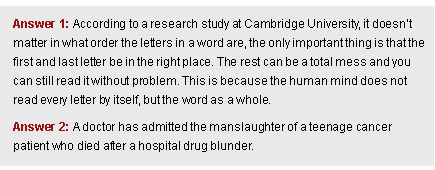Try reading the text below:

Even though the letters are not in the right order, many people are quite surprised to learn they can read the text with no problems. (see answers below) This may not be the whole truth, however.
The way Matt Davis of the MRC Cognition and Brain Sciences Unit at Cambridge University sees it, “there are elements of truth in this, but also some things which scientists studying the psychology of language know to be incorrect.” As far as he knows, he’s unaware of any research at Cambridge that might suggest otherwise.
Davis makes the point that the order in which the words were rearranged makes them fairly easy to read. Here are some alternate versions of the scrambled words:

So why is it that the passage versions are easier to decipher? It appears that a lot of the information absorbed during the reading process is contextual in nature. As a result, understanding a few words in a sentence can help us figure out the next one. In scanning for identifiable words, we seek out certain sounds and letter combinations. As you’ll note from the passage above, many of these markers were kept in place. As an example, in ‘according’ (aoccdrnig), the double cc was kept. Separating them though (aricdocng), makes the word far more challenging to read.
Similarly, in the word Cambridge (Cmabrigde) the second half of the word, ‘bridge’ was minimally changed. Scrambling up the letter order to break up ‘bridge’ as in Cgmiadrbe, makes it much more difficult to read.
As such, reading the following passage should be that much more difficult:








 English
English
 Français
Français


